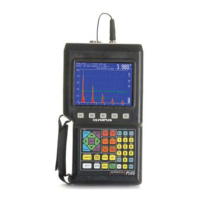66
EPOCH 4PLUS
draws and collects the echo envelope of the signal while also drawing the
live waveform. Match the live waveform with the maximum point
corresponding to the previously accumulated echo dynamic curve. Refer to
the figure above for a detailed schematic of using the Peak Memory feature
to find the BIP. Press [PEAK MEM] again to turn off the feature.
Figure 31 Locating the Beam Index Point
4. Hold the probe stationary once you have peaked up the signal and mark the side of the
transducer wedge directly over the “0” mark on the block. This is the BIP – the point
at which the sound leaves the wedge and enters the material with maximum energy.
7.5.2 Verifying the Refracted Angle (Beta)
The refracted angle of the probe should already have been entered in the EPOCH 4PLUS
in the initial steps of the calibration procedure. Although the wedge may be marked 45
o
,
for example, the actual refracted angle may be slightly different due to the properties of the
test material or the amount of wear on the wedge. It is necessary to verify the actual angle.
This ensures the EPOCH 4PLUS’s soundpath calculations are accurate.
To verify the refracted angle, follow these steps:
1. Position the probe over the appropriate angle mark on the block, which is 45
o
in this
example.

